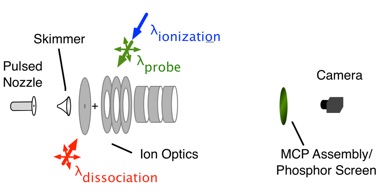Research in the Bartz Lab

Research in the Bartz laboratory focuses on photodissociation studies of NO-containing organometallic and organic compounds. Students in the lab use Nd:YAG-pumped dye lasers to photodissociate gas phase molecules and determine the vector correlations between and among the transition dipole (mu), recoil velocity (v), and angular momentum (J).
Velocity-Mapped Ion Imaging
Velocity-Mapped Ion Imaging (VMII) is a mass spectrometric technique where the initial product recoil velocity is mapped onto a 2-d detector. The mass spectrometer is housed in a high vacuum system with a base pressure of <10-7 torr. The molecules are carried into the mass spectrometer in a He carrier gas through a pulsed nozzle.

Fig 1. Schematic of a VMII instrument
Laser scheme
In our laboratory, we use a three-color laser technique. The first laser pulse dissociates the target molecule. The second laser (224 - 227 nm) excites the newly-formed NO products in the X --> A transition. The third pulse (308 nm) ionizes the excited NO products.
Ion detection
The NO+ ions are accelerated by the ion optics. They travel through a field-free region and strike a multichannel plate detector. The ion positions are detected as spots of light on a phosphor screen by a cooled CCD camera. The laboratory computer collects each of the ion images separately, determines the position of each ion, and stores the images on the hard drive.
Publications
-
1.J.A. Bartz, S. Odawara, S.A. Collier, K.M. Meisel, K.P. Burke, J.J. Cekola, and G.E. Leroi. "NO (v"=0) rotational distributions from the photodissociation of organometallic nitrosyls in the charge transfer region." J. Phys. Chem. A 105, 319 (2001).
-
2.J.A. Bartz, S.C. Everhart, and J.I. Cline. “Determination of the v-j vector correlation in the photodissociation of nitrosobenzene at 305 nm.” J. Chem. Phys. 132, 074310 (2010).
-
3.A.L. Peden, R.D. Kieda, K.A. Breck, J.R. Basore, C.A. Kent, and J.A. Bartz. “UV Photodissociation of η5-C5H5NiNO: A Jahn-Teller Excited-State Distortion Produces a Cartwheeling NO.” J. Phys. Chem. A, 114, 10922 (2010).
-
4.M.P. Grubb, M.L. Warter, C.D. Freeman, N.A. West, K.M. Usakoski, K.M. Johnson, J.A. Bartz, and S.W. North. “A method for the determination of speed-dependent semi-classical vector correlations from sliced image anisotropies.” J. Chem. Phys., 135, 094201 (2011).
-
5.M. Hossain, A.J. Klobuchar, and J.A. Bartz, The photodissociation of N,N-dimethylnitrosamine at 355 nm: The effect of excited-state conformational changes on product vector correlations. J. Chem. Phys., 2017, 147, 013925.
-
6.Fairhall, A. J.; Orlando, M. M.; Bartz, J. A. 355 nm Photodissociation of N2O3 Revealed by Velocity-Mapped Ion Imaging. J. Phys. Chem. A 2020, 124, 472-478. DOI:10.1021/acs.jpca.9b08688

Leo Sota (’20)
Alex Cruz (’21)
Angela Ruiz (’21)
Subi Thakali (’21)


??? at 355 nm
Shows a parallel transition generating NO -- mystery molecule in our experiment! Stay tuned...


Chemical Dynamics and Ion Imaging

